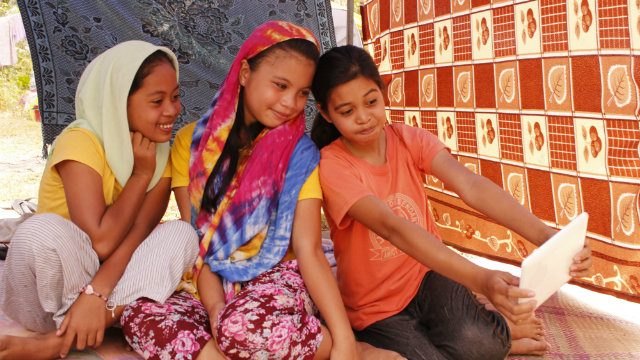SUMMARY
This is AI generated summarization, which may have errors. For context, always refer to the full article.

MAGUINDANAO, Philippines – They were taking selfies on a tablet and singing to a Korean song to pass the time on a hot, lazy afternoon.
Naima, Nashiba, and Muhaipha are typical teenage girls. They enjoy singing, hanging out with their friends, and occasionally experimenting with make-up.
Naima, 12, was wearing a light shade of purple eye shadow on her almond-shaped eyes. It was a color that matched the colorful tye-died shawl she used to cover her hair, with the ends falling over her shoulders.
“Even if we don’t get to go out much, it’s ok. We just stay home and study. I like studying Arabic and English,” said Muhaipa, the most outspoken of the 3. At 13, her wide deep-set eyes were telling of her gregarious nature.
Her older sister, Nashiba, 15, was the quiet one with a smile as easy-going as her loose orange shirt and jeans.
Afternoons are long, humid, and hot in the evacuation camp the girls and about 600 families or about 3,000 people have made their home for the last 3 days.
Mats and pillows strewn on the dry dusty soil are sitting areas during the day and sleeping quarters during the night. Old blankets, tattered rugs and faded tarpaulins pulled together on skinny wooden poles serve as a roof over their head.
“Sometimes it’s hard to sleep in the evening when you hear the gunfire or the airplanes. The louder, the scarier – it sounds so near, ” said Muhaipha, turning her index finger in a circular motion to mimic the whirring sound of planes.
As of March 16, more than 120,000 Filipinos in Muslim Mindanao have been displaced by the military offensives against Moro rebels, according to ARMM Humanitarian Emergency Action and Response Team (HEART).
‘Bakwit’
The soldiers came last Friday, March 13, they said. The girls and their families waited until Saturday when it was safe to gather their belongings and run to safer ground.
“I grabbed clothes, pots, pans, and as much rice as I could,” recounted Naima.
“I was able to pack those, too, along with my clothes, some underwear, (sanitary) napkins and other personal stuff for hygiene,” Muhaipha said, very proud of herself.
The girls walked about 3 kilometers to seek refuge in the next town, Tulunan in Datu Anggal Midtimbang.
Hauling their possessions on their back was a heavy burden for their petite frames.
The first time they fled the fighting, they were toddlers carried by their parents or other relatives.
“We did not know what was happening then. We just brought our dolls and toys,” recalled Muhaipha.
The years after were a blur, making it difficult to remember when things happened. They remember more because of the years they lost, the years that set them back in school.
“I couldn’t graduate from kinder because we were displaced,” recalled Naima.
All 3 girls are old for their grade levels. At 15, Nashiba is in grade 7, along with a mix of 12 and 13 year-old children. She is in the same grade level as her sister, Muhaipha. Naima is a 12-year-old 5th grader.
The girls consider themselves bakwit (evacuee) veterans by now.
It was easier being a bakwit when they were younger. There were other children in the IDP (internally displaced persons) camp to play with and while away the time.
But now that they are teens, it is a bit more complicated. Being a girl, especially so.
‘Come back home’
Napkins are hard to come by on tight daily budgets, but they are a luxury when one is displaced. Most of the time, the girls improvise by tearing up using old clothes and using it as a substitute for a sanitary pad.
“Like this,” Naima demonstrated folding a piece of paper to a length and width that would line the underwear crotch area.
“You can’t wear a loose panty, or else!” squealed Muhaipha, laughing.
During their period, the girls limit their movement, careful not to stain their clothes.
It is considered haram or forbidden for others to see (menstrual) blood.
Daily hygiene routines like taking a bath take a long time not because of personal vanity and indulgence but because there are only two bathrooms in the evacuation center for all the residents. The girls spend as much as 4 hours a day – two hours in the morning and two hours in the afternoon – in line to take a bath.
In the morning, they line up at 11am, when lines trickle down to a minimum, and in the afternoon, at 4pm so they can go home before it is dark.
It would be much easier to avoid a bath – and the lines – altogether, but they have nothing much to do anyway except help out with the cooking chores.
“If we had school, we would be at home studying,” said Muhaipha.
Silence sets in and the girls cast their eyes downward.
Naima is the first to break the silence. “I sometimes lose hope. I don’t know when I can go back to school. I might have to stop again. I don’t know if I can finish school at all.”
“I want to finish school. I want to be a teacher and help my parents. They work so hard. Life is hard when you are always running,” Nashiba quietly added while a Korean song played.
They only words she understood were “come back home.” – Rappler.com
Tabang Sibilyan: Help internally displaced people in Mindanao
Do you know other humanitarian efforts aimed at providing for the IDPs in Mindanao? Let us know by emailing move.ph@rappler.com.
Add a comment
How does this make you feel?
There are no comments yet. Add your comment to start the conversation.